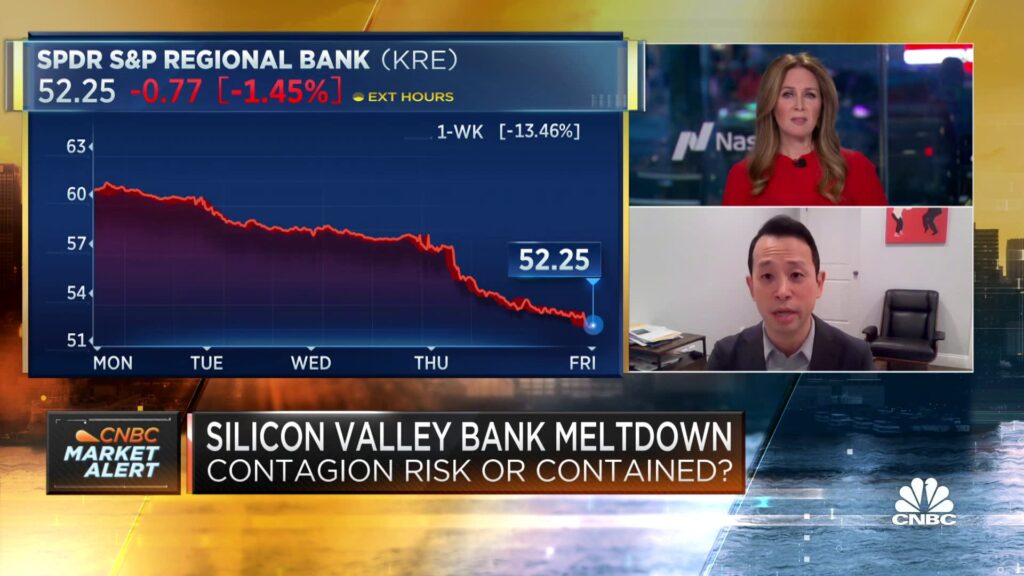
In the video titled “Risks of Crypto Contagion From SVB Collapse” by Bloomberg Technology, CoinRoutes CEO Dave Weisberger joins Caroline Hyde and Ed Ludlow to discuss the potential risks of the banking system contagion on crypto and technology companies. Weisberger argues that there is more danger to these sectors from the banking system than vice versa. He explains that the core principle of crypto and Bitcoin is to eliminate the need for centralized trust and counterparty risk, making them fundamentally different from fractional reserve banking. He also highlights that while certain assets in the crypto market may be negatively impacted, events like the SVB collapse can be seen as beneficial in the long run for the crypto complex.
Weisberger further emphasizes that past incidents in the crypto market have not significantly affected the traditional financial system, indicating the limited impact of these events. He discusses the three major failures in the crypto world in 2022, which could have been prevented with better regulation and disclosure practices. Weisberger’s argument revolves around the idea that the risk of contagion from the banking system poses more threat to crypto and tech industries than the risks posed by crypto to banks themselves. The discussion touches on topics such as stablecoins, disclosure practices, and the influence of high rates on the market, providing valuable insights into the potential implications of the SVB collapse on crypto companies and the financial system as a whole.
Risks of Crypto Contagion From SVB Collapse

This image is property of i.ytimg.com.
Introduction
Investing in cryptocurrencies, such as Bitcoin and Ethereum, can be a rollercoaster ride. The volatile nature of these digital assets often attracts both seasoned investors and adventurous individuals looking for quick gains. However, recent events, such as the collapse of the digital financial services firm SVB, have raised concerns about the potential risks of crypto contagion. In this article, we will explore the various risks associated with the collapse of financial institutions and how they could impact the thriving world of cryptocurrencies.
The Opposite of Fractional Reserve Banking
Traditional banking operates under the principle of fractional reserve banking, where banks hold a fraction of their customers’ deposits and lend out the rest to generate profits. This practice provides stability and liquidity to the financial system. However, cryptocurrencies operate on a different principle – decentralized finance. Unlike traditional banking, the value and stability of cryptocurrencies depend on a decentralized network of participants, where transactions are recorded on a blockchain ledger. This fundamental difference makes cryptocurrencies vulnerable to systemic risks.
Long-Term Bullish for Crypto
Despite the risks associated with the collapse of financial institutions like SVB, the long-term outlook for cryptocurrencies remains bullish. The world of decentralized finance presents opportunities for financial innovation and democratization. As more people become aware of the benefits of cryptocurrencies, such as faster and cheaper transactions and increased privacy, the demand for digital assets is likely to grow. Additionally, the collapse of traditional financial institutions could further fuel the adoption of cryptocurrencies as a viable alternative.
Systemic Issue Across Banking?
While the collapse of individual financial institutions may not directly impact the entire banking system, it raises the question of whether there is a systemic issue across the banking sector. The interconnectedness of the global financial system means that the failure of one institution can have ripple effects on others. In the case of cryptocurrencies, this systemic risk could result in a loss of trust and confidence, leading to a potential crash in the market.

This image is property of i.ytimg.com.
Incidents in Crypto vs Mainstream
It is worth noting that incidents of financial collapse and fraud are not unique to the world of cryptocurrencies. Traditional financial institutions have also faced their fair share of scandals, such as the collapse of Lehman Brothers during the 2008 financial crisis. The difference lies in the transparency and regulatory oversight of the two sectors. While mainstream financial institutions are subjected to strict regulations and disclosure requirements, the same cannot be said for many cryptocurrencies and blockchain projects. This lack of transparency can exacerbate the risks associated with crypto contagion.
Preventable Failures in Crypto
One of the main challenges faced by cryptocurrencies is the prevalence of preventable failures. In the absence of rigorous regulation and oversight, projects and exchanges may suffer from poor management, security vulnerabilities, or inadequate risk management practices. These failures can lead to financial losses for investors and create a negative perception of cryptocurrencies in general. It is crucial for the crypto industry to address these issues and establish robust standards to mitigate the risks of contagion.

This image is property of i.ytimg.com.
Bad Disclosures and Regulatory Issues
Another risk factor in the crypto space stems from the lack of standardized disclosure practices and regulatory oversight. Unlike traditional financial institutions, which are required to disclose their financial statements and undergo regular audits, many cryptocurrencies and blockchain projects operate in a regulatory gray area. This lack of transparency makes it difficult for investors to assess the true financial health of these projects. Furthermore, the absence of regulatory oversight leaves little recourse for investors in the event of fraud or misconduct.
Theft and Fraud in Crypto
The decentralized nature of cryptocurrencies makes them attractive targets for theft and fraud. Incidents of hacking and fraudulent activities have plagued the crypto industry, resulting in significant financial losses. The lack of proper security measures and regulatory oversight has allowed these incidents to occur. The high-profile Mt. Gox exchange hack in 2014, where millions of dollars’ worth of Bitcoin were stolen, serves as a chilling reminder of the risks associated with keeping digital assets in unsecured platforms.

This image is property of www.politico.eu.
Impact on the Traditional Financial System
While cryptocurrencies have the potential to disrupt the traditional financial system, the collapse of financial institutions can also have an impact on the crypto market. A loss of trust and confidence in the banking sector can drive individuals and institutions towards cryptocurrencies as a safer and more transparent alternative. However, if the collapse of financial institutions triggers a broader economic crisis, it could lead to a decline in demand for cryptocurrencies as people prioritize more immediate financial concerns.
High Rates and Market Froth
One factor that contributes to the risks of crypto contagion is the prevalence of high-interest rates and market froth. The allure of high returns often attracts speculative investors who may not fully understand the risks involved in the crypto market. This speculative behavior, combined with a lack of regulation and oversight, can create an environment of market froth and irrational exuberance. In such a scenario, the collapse of one major player can trigger a domino effect, leading to a rapid decline in the value of cryptocurrencies.

This image is property of image.cnbcfm.com.
Impact on Stable Coin Proponents
Stable coins, such as Tether and USD Coin, are cryptocurrencies pegged to a stable asset, such as the US dollar. These coins aim to provide stability and reduce the volatility commonly associated with cryptocurrencies. However, the collapse of financial institutions can undermine the credibility and stability of stable coins. If the institutions backing these stable coins fail, it could result in a loss of trust and a run on these assets, creating a broader impact on the value and viability of stable coins.
In conclusion, the collapse of financial institutions, like SVB, poses significant risks to the crypto market. While the decentralized nature of cryptocurrencies offers opportunities for innovation and democratization, it also exposes the industry to systemic risks. The lack of transparency, regulatory oversight, and security measures in the crypto space amplifies the potential for contagion. However, by addressing these risks through improved regulation, better risk management practices, and enhanced security measures, the crypto industry can navigate these challenges and continue to thrive in the long term.



